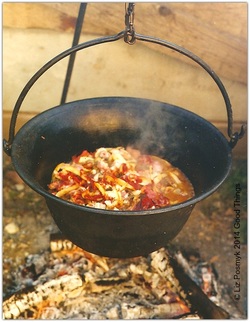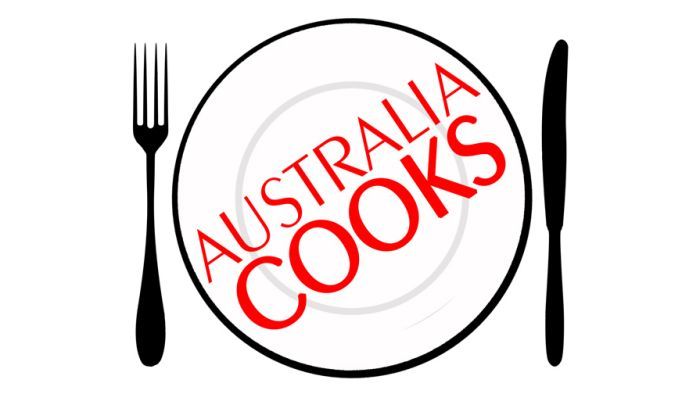It would be little wonder if Hungarian goulash had complained of an identity crisis over the years. Recognised internationally as a stew (and frequently bastardised in various ways), the famous icon of Hungary is a thick and wholesome soup named after the nomadic Magyar herdsmen or gulyás of the Great Plain.
In The Cuisine of Hungary (Penguin), George Laing explains that goulash is [one of] 'the four pillars of Hungarian cooking' and the origins can be traced back to the ninth century, when 'the ancient Magyars dipped into the gulyás with their wooden spoons'. Yeah, those guys knew how to eat with gusto!
At its best, goulash is cooked outdoors in an iron kettle or bogrács suspended over an open fire (per my cousin György's method in the photograph above). Add a generous blob of pork lard during the cooking (if you dare) and make sure you have large chunks of home-baked bread sliced and ready. Then invite a loud and ravenous family over, and finish off with Liszt’s Hungarian Rhapsody belting out from the ipod dock. If you don't happen have a bogrács, which Hungarians transport to picnics much like other nationalities might do with a picnic basket or an esky, then cook your goulash in a soup pot indoors. Jó étvágyat kívánok! Enjoy. GOULASH THE WAY MY MOTHER TAUGHT ME (Gulyás) 1-2 tablespoons oil 2 brown onions, chopped 1kg beef shin (or stewing steak), cubed and trimmed of fat 1 tablespoon Noble Sweet Hungarian paprika 2 carrots, peeled & cut into chunks 1 green capsicum, sliced 1 tomato, chopped 1 teaspoon salt (to taste) up to 2 litres water 3 potatoes, peeled and quartered a few sprigs of parsley a few caraway seeds (entirely optional) Heat the oil in a large saucepan or stock pot and saute the onions until they are just golden. Add the beef and cook it until it is well browned. Stir in the paprika, carrot, capsicum, tomato, salt and one litre of water. Bring the soup to the boil, the lower the heat, cover the pot and cook the goulash gently for up to two hours. At this stage, add the potatoes and parsley, and up to an additional litre or so of water (less if you prefer a less liquid Goulash). Then simmer until the potatoes are tender. Serves 6. PINCHED NOODLES (Csipetke) 11/2 cups plain flour 1/2 teaspoon salt 2 tablespoons water 1 free range egg Combine the ingredients in a bowl and mix well. Knead to a firm, dry consistency. Grate directly into simmering soup or pinch off 1 cm pieces and drop into the soup. The noodles are ready when they rise to the top. Serves 6. Note: Please respect my literary work and do not copy. Kindly ask permission before re-blogging. Please provide full acknowledgement to Bizzy Lizzy's Good Things with a visible link back to my original blog post.
This recipe is one of my favourites from the archives... it was among the first few recipes that appeared on Good Things. I thought it was time to share it more widely. Tell me dear readers, have you ever eaten goulash cooked in the traditional Magyar way? Perhaps you have travelled to Hungary? Share your stories here... I'd love to hear from you!
Maryna
18/7/2014 01:52:34 am
Hey Lizzy! We connected on Twitter recently. I only just managed (time wise) to follow you and saw you were of Hungarian background.
Louis D'Cruz
18/7/2014 01:52:59 am
Hi Lizzy, Made the goulash following your recipe last night...a success on every front! Thanks for sharing. Will add this to my winter repertoire...Cheers, Louis
Lenore
18/7/2014 01:53:18 am
I will definitely try this recipe Liz and those noddles sound interesting. I wonder if they can be made with Gluten free flour?
Lizzy
19/7/2014 12:51:36 pm
Hi Lenore, yes the noodles can be made with gluten free flour xo
Krista Bjorn
18/7/2014 01:53:44 am
I'm very fortunate to live close to dear Hungarian friends who are constantly introducing me to new and delicious Hungarian dishes. I do so love goulash. :-)
Lizzy
19/7/2014 12:51:50 pm
Isn't that wonderful, Krista!
Lizzy
19/7/2014 12:52:29 pm
Hi Sally... yes, the pinched noodle is not unlike spaetzle, though drier. Thanks for your kind words!
Eha
18/7/2014 03:07:20 pm
Methinks I oft ate this as a small bub in N Europe already but was taught to make it 'properly' when I married my second Hungarian husband here in Australia . . . actually the lessons we learned were pretty similar :) ! Still make it occasionally but usually accompany it with galuska made from a slightly more liquid mix and dropped into boiling water thru' a colander, madly cutting under the holes all the time . . . :) ! Fusion cook the latter for many dishes actually . . . !!!
Andrea
18/7/2014 10:02:39 pm
I'm feeling hungry Eha!!!
Lizzy
19/7/2014 12:53:06 pm
Andrea : )
Lizzy
19/7/2014 12:52:56 pm
Yes, sounds good Eha : )
Lizzy
19/7/2014 12:53:24 pm
Oh, the memories of that day my cousin made this, so delicious! : ) 18/7/2014 05:56:22 pm
Family recipes are usually the best Lizzy, and this does sound yummy! The thought of the iron pot bubbling away over an open fire is making me drool! X
Lizzy
19/7/2014 12:53:40 pm
Me too, Bec... it was so good! xo
Andrea
18/7/2014 10:01:51 pm
I am SO going to make your Hungarian goulash!!!!!!! Xx
Lizzy
19/7/2014 12:53:55 pm
Andrea, thank you, I do hope you enjoy it xo 19/7/2014 06:06:35 am
Liz - this reminds me so much of the Gulaschsuppe I has in Germany when I was a teen. I have seen many recipe but not one, except yours, includes the noodles, which I remember as spätzle. I can't wait till the weather cools so I can try this!
Lizzy
19/7/2014 12:54:26 pm
Hi David... the noodles are not dissimilar to spaetzle, only drier. Comments are closed.
|
Welcome...Üdvözölöm
Cooking and writing have been a lifelong passion. Join me as I share with you my favourite recipes; postcards and morsels from my travels; conversations with cookery writers and chefs; and news on food, cookbooks and cooking. - Liz Posmyk
All
NB: I use Australian standard measuring cups and spoons in my recipes.
|







